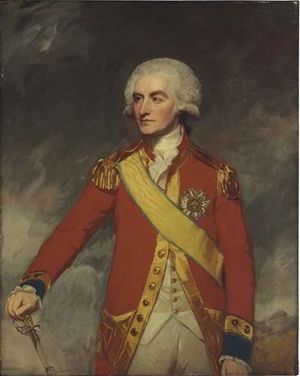John Mackenzie, Lord MacLeod facts for kids
Quick facts for kids
John Mackenzie
Lord MacLeod, MP
|
|
|---|---|
 |
|
| Born | 1727 Castle Leod near Strathpeffer, Scotland
|
| Died | 2 April 1789 (aged 61–62) Edinburgh, Scotland
|
| Resting place | Canongate Kirkyard, Edinburgh, Midlothian, Scotland |
| Title | Member of Parliament |
| Term | 1780–1784 |
| Political party | Tory |
| Spouse(s) | Margery Forbes, daughter of James Forbes, 16th Lord Forbes |
| Parent(s) | George Mackenzie, 3rd Earl of Cromartie |
| Awards | Commander, Order of the Sword of Sweden |
| Notes | |
|
Lieutenant (Clan MacLeod), Lieutenant-General (Swedish Army), Regimental Colonel (Highland Scotland), Major-General (British Army)
|
|
John Mackenzie, Lord MacLeod (1727–2 April 1789) was a Scottish politician and soldier. He was known for his exciting life. He fought in wars and served in different armies. He also became a Member of Parliament in Britain.
Contents
A Life of Adventure
Early Years and Challenges
John Mackenzie was born in 1727. His home was Castle Leod near Strathpeffer, Scotland. He was the oldest son of George Mackenzie, 3rd Earl of Cromartie. His mother was Isabel Gordon.
When he was young, John joined a rebellion. This was the Jacobite rising of 1745. He fought with his father's clan. They were called Cromartie's Regiment. John was captured in 1746. This happened just before the Battle of Culloden. He was held prisoner with his father.
John was later pardoned. This meant he was forgiven. He did not have to go to trial. This allowed him to start a new life.
A Soldier in Europe
After the rebellion, John left Scotland. He moved to Berlin. There, he met Field Marshal Keith. Keith helped him join the Swedish Army in 1750. John became a mercenary. This means he was a soldier who fought for money. He served in Swedish Pomerania.
John was a very good soldier. He served Sweden for 27 years. He rose through the ranks. He became a Lieutenant-General. He also received an important award. It was called the Commander, Order of the Sword of Sweden.
During the Seven Years' War, he also joined the Prussian Army. He fought as a volunteer. He was even given the title of Count in Sweden.
Back in Scotland
In 1771, John Mackenzie returned to Scotland. He became a Colonel. He led a new Scottish regiment. It was called the 73rd Foot.
In 1778, King George III recognized his Swedish title. This was a special honor. From 1779, John served in the East Indies. He fought in a campaign against Hyder Ali. His regiment faced a tough battle. It was called the Battle of Conjeveram.
After this, John returned to Scotland. He remained the Colonel of his regiment. He was promoted to Major-General in 1784.
Politics and Later Life
Back in Scotland, John Mackenzie settled in Ross-shire. He entered politics. He became a Member of Parliament. He served from 1780 to 1784. He was a member of the Tory party.
In 1784, he got his family's estates back. He paid money to clear old debts. He spent the rest of his life improving the land. He planted many trees. He also built a new house. It was called Tarbat House.
John Mackenzie passed away in Edinburgh. This was on 2 April 1789. He had been ill for a year. He was buried at the Canongate Kirkyard in Edinburgh. He did not have any children. His estates went to his cousin, Kenneth Mackenzie.


